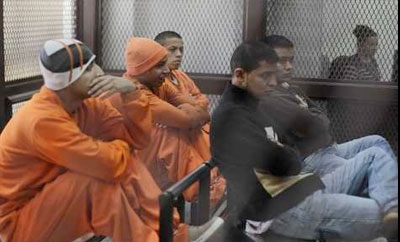A key witness in the trial for a Zetas massacre in Guatemala has revealed how the Mexican cartel’s original high standards and demand for well-trained recruits with a military background began to wane as its territorial influence expanded.
The recorded statement of a protected witness was played before a judge in the trial of nine men — two Mexicans and seven Guatemalans — accused of participating in the May 2011 torture and decapitation of 27 farmers in the Peten region of Guatemala, reported Prensa Libre.
Identified simply as “B,” the witness gave details on the structure of the Zetas in Guatemala, the group responsible for the massacre, and how the group developed after establishing itself in the country in 2003.
The witness, a former member of the Kaibiles — Guatemala’s elite Special Forces unit — said, “At the start, the Zetas only recruited Guatemalan and Mexican military members. They preferred those who had been Kaibiles and were out of the army. Later, though, they started to admit civilians and members of “mara” street gangs.” According to the witness, recruits were offered monthly salaries of up to $1,700.
Guatemalan recruits would then travel to Mexico, where they spent six months learning survival techniques and received weapons training. The witness, due to his previous training with the Kaibiles, was an instructor and recruiter in Guatemala, reported Prensa Libre.
The witness said it was after his training that he first met Z200, identified by Guatemalan prosecutors as Mauricio Guizar Cardenas, alias “El Amarillo,” who was the first Zetas commander in charge of Guatemala and the man who ordered the 2011 Peten massacre. The massacre was part of the Zetas battle with the Gulf Cartel — the Zetas’ former employers — for control of Guatemala’s drug trafficking routes.
InSight Crime Analysis
The Zetas’ recruitment of ex-military personnel initially made them a highly militarized and disciplined organization. In his testimony, the witness tells how the Zetas in Guatemala organized around two head commanders, with each sub-region having its own commander that directed four “stakes,” or cells dedicated to killing the opposition and robbing farms. In essence, the Zeta’s saw themselves as a military group, whose primary objective was to control territory, and then the illicit activities taking place there.
SEE ALSO: The Zetas in Guatemala
The group’s incursion into Guatemala reached its height in 2011, the year of the Peten massacre. Yet, as highlighted by the witness, the Zetas expansion made it necessary to open recruitment to non-military personnel, diluting the cohesion of the organization and lessening overall discipline.
For the Zetas, once the most fearsome and violent organization in Guatemala, holding territory has since become difficult, and the group’s influence has gone into decline.

